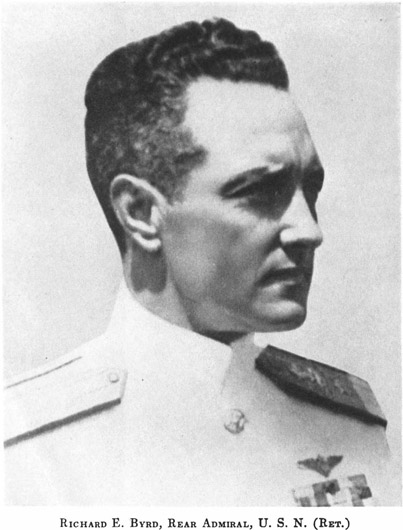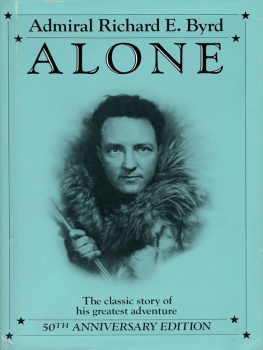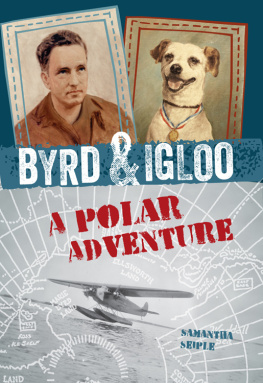Exploring with BYRD

Published by Rowman & Littlefield
A wholly owned subsidiary of The Rowman & Littlefield Publishing Group, Inc.
4501 Forbes Boulevard, Suite 200, Lanham, Maryland 20706
www.rowman.com
Unit A, Whitacre Mews, 26-34 Stannary Street, London SE11 4AB
Distributed by NATIONAL BOOK NETWORK
Copyright 1937 by Richard E. Byrd
Cloth edition originally published by G. P. Putnams Sons in 1937
Cloth edition by the Easton Press 1990
First Rowman & Littlefield paperback edition 2015
All rights reserved. No part of this book may be reproduced in any form or by any electronic or mechanical means, including information storage and retrieval systems, without written permission from the publisher, except by a reviewer who may quote passages in a review.
British Library Cataloguing in Publication Information Available
Library of Congress Cataloging-in-Publication Data Available
Paperback: 978-1-4422-4168-8
E-book: 978-1-4422-4169-5
 The paper used in this publication meets the minimum requirements of American National Standard for Information SciencesPermanence of Paper for Printed Library Materials, ANSV/NISO Z39.48-1992.
The paper used in this publication meets the minimum requirements of American National Standard for Information SciencesPermanence of Paper for Printed Library Materials, ANSV/NISO Z39.48-1992.
Printed in the United States of America
ILLUSTRATIONS
Richard E. Byrd, Rear Admiral, U. S. N. (Ret.)
Pensacola 1918
A Hazardous Undertaking
Wreck of the America
Whales Trapped in a Crack
The Fokker on a Frozen Lake
Victim of the Winds Fury
Coasting Down the Glacier
The City in Her Toughest Battle
The Jacob Ruppert Approaches the Bay Ice
A Stately Promenade
Admiral Byrd Steps Ashore
Four Years of Ice Crystals in the Old Tunnel
Blazing a Trail Through the Pressure
On the Main Highway to Little America
Scenes at Advance Base
Life During the Winter Night
Planning a Flight
The William Horlick Comes Out of Its Winter Cocoon
Heating the Motors
The Radio Staff

EXPLORING WITH BYRD
Chapter I

EDUCATION OF A PILOT
ONE of my first and most striking impressions of aviation came the day a man rushed into my stateroom aboard the battleship waving a newspaper that had just been brought us by the pilot.
For Gods sake, listen to this! he exclaimed. "Jack Towers has fallen fifteen hundred feet in an airplane and lived to the tale.
I couldnt believe it.
He was thrown out of his seat. (In those days the flyer sat right out in the open on a little bench.) "But he caught by a brace and dangled in mid-air. On the way down he kicked at the control wheel. Apparently he righted the plane just before it hit . Think of the nerve of the man!
I did think of his nerve; and many times since Ive admired the courage of those early pilots who flew thousands of feet in the air with defective machines about which they knew almost nothing. And its good to feel that my friend, Captain John W. Towers, U.S.N., the hero of the incident, is alive today and still a flyer of note.
The horror people felt fifteen years ago in reading about Towers escape is still felt when newspapers print tragic details of some aeronautical accident without regard for technical reasons behind the accident. As a result many citizens still look on flying as one of the most attractive forms of suicide.
If I had a son twenty years old today and he should come to me with the question: Is it all right for me to fly? Id answer: Go to it. And I hope you get your pilots license soon because I want you to do a lot of flying before youre through.
He might break his neck. But also he might be run over by a taxi, burn up, catch pneumonia, or be struck by lightning. Those things happen to people every day.
My first aerial adventure was in the Annapolis gymnasium. I was captain of the Navy Gym Team, which was out to win the intercollegiate championship of the year. In line with this ambition I devised a hair-raising stunt on the flying rings. My plan was to get a terrific swing, high enough to be able to count on an appreciable pause at the end of it.
I figured I could at this moment do what was called dislocate, which meant swing completely head over heels without changing grip, with arms at full lengthunbending and forcing my shoulders through a quick jerk, that made it look as if they were put out of joint. In addition, I was going to make another complete turn, legs outside, letting go with my hands as my ankles passed my forearms, and catching again as I fell.
The day before the meet the gym was crowded with people watching practice. I hoped that my stunt would give us the points needed to win. Never before had I reached the altitude I reached that afternoon when my last turn came on the rings. I was conscious of the dead silence as I swooped through the air for my final effort.
With a quick whirl I dislocated. It felt all right. The next second I was spinning into the second turn. I let go; caughtbut only with one hand. For an instant I strained wildly to catch the other ring. But it had gone. People after-wards told me that a queer sharp sigh went up from the crowd at this moment.
I fell. It was a long way down even for a flyer. I came down more or less feet foremost. The crash when I struck echoed from the steel girders far above me, and there was a loud noise of something snapping. I tried to rise, but fell back stunned. The effort told me though, that I was far from dead. I noted there was no feeling in my right leg. I glanced down as willing hands came to lift me and saw that my ankle and foot were badly crumpled; the same foot I had broken playing football against Princeton.
That was December, 1911. I was to graduate in June. I missed the semi-annual examination and was absent from the class room for months while I wrestled with nature on one hand and with the specter of academic failure on the other. The Navy made no allowances for me and wanted me to go back a class. I dont believe I could have pulled through but for my great desire to go out into the fleet with my classmates. When I returned to the Academy, the bones in my foot and leg had all knit but one. The bony knot on the outer side of my right ankle was still in two pieces. It clicked when I walked. Some one told me if I walked a lot I would grate the fragments together and induce flow of osseous fluid. I did this for weeks. It hurt; but it apparently worked. I had to take my semi-annual examinations and my final examinations at the same time. After a great struggle I managed to graduate.
The struggle I had made to graduate taught me a great lessonthat it is by struggle that we progress. I learned concentration during that time I never thought I possessed.
My time in the battleship fleet was a great experience. One day I fell down a gangway and did something to that bum leg of mine. The surgeons decided to nail the bone together.
Several years passed, and my leg did not get entirely well. The Navy Regulations would not allow my promotion on account of it. Finally I was retired on three-quarters pay; ordered home for good. Career ended. Not enough income to live on; no chance of coming back; trained for a seafaring profession and temperamentally disinclined for business.
Next page








 The paper used in this publication meets the minimum requirements of American National Standard for Information SciencesPermanence of Paper for Printed Library Materials, ANSV/NISO Z39.48-1992.
The paper used in this publication meets the minimum requirements of American National Standard for Information SciencesPermanence of Paper for Printed Library Materials, ANSV/NISO Z39.48-1992.
